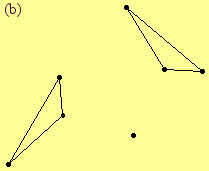3.5.1 Reflections and Glide Reflections
![]() Printout
Printout
The mathematical sciences particularly exhibit order, symmetry, and limitation;
and these are the greatest forms of the beautiful.
—![]() Aristotle (384–322 B.C.)
Aristotle (384–322 B.C.)
Definition. A reflection in a line l is a
transformation of a plane, denoted Rl, such that if X is on l, then Rl(X) = X,
and if X is not on l, then Rl maps X to X' such that l is the
perpendicular
bisector of The line l
is called the axis
of the reflection.
Definition. A glide reflection, denoted GPQ, is the
composition of the reflection with axis and the nonidentity
translation TPQ,
i.e.
.
Investigation Exercises. Is each
transformation an isometry? If yes, is it a direct or indirect isometry?
3.67. Draw a right
triangle with right angle at C. Accurately draw its image under each transformation.
(a)
Rl where
(b)
Rl where
(c)
GAC
(d) GBC
3.68. Draw the image of each transformation (a) Rl (b) GPQ.
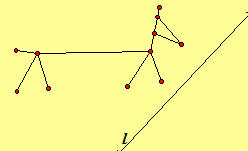
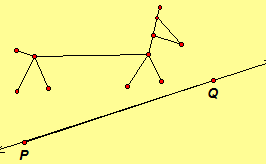
Click here to investigate
dynamic illustrations of the above
diagrams with
GeoGebra or
JavaSketchpad.
3.69.
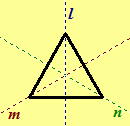 Complete the table of the compositions of
symmetries for an equilateral triangle.
An animation sketch is available for Geometers Sketchpad in
Geometers Sketchpad and
GeoGebra Prepared Sketches and Scripts.
Complete the table of the compositions of
symmetries for an equilateral triangle.
An animation sketch is available for Geometers Sketchpad in
Geometers Sketchpad and
GeoGebra Prepared Sketches and Scripts.
|
|
I = RO,0 |
RO,120 |
RO,240 |
Rl |
Rm |
Rn |
|
I = RO,0 |
|
|
|
|
|
|
|
RO,120 |
|
|
|
|
|
|
|
RO,240 |
|
|
|
|
|
|
|
Rl |
|
|
|
|
|
|
|
Rm |
|
|
|
|
|
|
|
Rn |
|
|
|
|
|
|
Is the set of symmetries of an equilateral triangle a group? Explain.
3.70. Complete a table of the compositions of the symmetries for a square. Is the set of symmetries of a square a group? Explain.
3.71. For each diagram, draw the axes of a composition of reflections that map one triangle onto the other triangle. What is the fewest number of axes of reflection that can be drawn?
|
|
|
|
|
Theorem 3.19. A reflection of a neutral plane is an
isometry.![]()
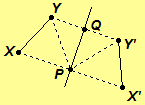 Proof. Let Rl
be a reflection of a neutral plane. Let X
and Y be any two distinct points with
X' = Rl(X) and Y' = Rl(Y). We need to show XY = X'Y'. One of the following is true: (1) X and Y are on the same
side of l. (2) X and Y are on opposite
sides of l. (3) One of X and Y are on l. (4) Both X and Y are on l. We prove case
1 and leave the other cases as an exercise.
Proof. Let Rl
be a reflection of a neutral plane. Let X
and Y be any two distinct points with
X' = Rl(X) and Y' = Rl(Y). We need to show XY = X'Y'. One of the following is true: (1) X and Y are on the same
side of l. (2) X and Y are on opposite
sides of l. (3) One of X and Y are on l. (4) Both X and Y are on l. We prove case
1 and leave the other cases as an exercise.
Assume X and Y are on the same
side of l. By definition of the
reflection Rl, l is the perpendicular
bisector of
segments and
Hence, there are points P and Q on l such that
,
,
,
and
Thus, since
,
we have
by
SAS. Hence,
and
By angle subtraction,
.
Hence, by SAS,
Therefore, by the definition of congruent
triangles and
congruent segments, XY =
X'Y'. The proofs that XY = X'Y'
for the other cases is left as an exercise. Hence the reflection Rl is an isometry.//
Theorem 3.20. The inverse of a reflection of a neutral plane is the reflection itself.
Theorem 3.21. Every point on the axis of reflection is invariant under a reflection of a neutral plane.
Theorem 3.22. All lines perpendicular to the axis of reflection are invariant under a reflection of a neutral plane.
Theorem 3.23. For any two distinct points X and Y in a neutral plane, there exists exactly one reflection that maps X to Y.
Proof. Let X
and Y be two distinct points in a neutral
plane. There exists a unique perpendicular bisector l of the segment Hence, by the definition of a reflection, Rl is the unique reflection
that maps X to Y.//
Theorem 3.24. A glide reflection of a Euclidean plane is an isometry.
Theorem 3.25. The axis of a glide reflection is the only invariant line under a glide reflection of a Euclidean plane.
Theorem 3.26. A glide reflection of a Euclidean plane has no invariant points.
Theorem 3.27. Every isometry of a Euclidean plane is the composition of
at most three reflections.![]() (For a dynamic diagram,
GeoGebra or
JavaSketchpad.)
(For a dynamic diagram,
GeoGebra or
JavaSketchpad.)
Proof. Let f
be an isometry of a Euclidean plane, and let X, Y, and Z be any three
noncollinear points. Further, let X'
= f(X), Y' = f(Y),
and Z' = f(Z).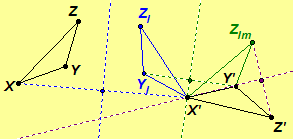 By
Corollary 3.10,
we only need to find a composition of three reflections that maps X, Y, and Z to X', Y', and Z', respectively. If X and X' are distinct, then by Theorem 3.23 there is a unique reflection Rl that maps X to X'.
Let Yl = Rl(Y) and Zl = Rl(Z). Similarly, if Yl
and Y' are distinct, there is a
unique reflection Rm that
maps Yl to Y'. Since f and Rl are
isometries, X'Y' = XY = X'Yl.
Hence, X' is on line m the perpendicular bisector of
By
Corollary 3.10,
we only need to find a composition of three reflections that maps X, Y, and Z to X', Y', and Z', respectively. If X and X' are distinct, then by Theorem 3.23 there is a unique reflection Rl that maps X to X'.
Let Yl = Rl(Y) and Zl = Rl(Z). Similarly, if Yl
and Y' are distinct, there is a
unique reflection Rm that
maps Yl to Y'. Since f and Rl are
isometries, X'Y' = XY = X'Yl.
Hence, X' is on line m the perpendicular bisector of and X'
= Rm(X'). Thus, the composition
maps X
to X', Y to Y', and Z to some point Zlm. As before, if Zlm
and Z' are distinct, there is a
unique reflection Rn that
maps Zlm to Z'. Since f, Rl, and Rm are isometries, X'Z' = XZ = X'Zl = X' Zlm and Y'Z' = YZ = YlZl = Y' Zlm. Hence, X'
and Y' are on line n the perpendicular bisector of
,
X' = Rn(X') and Y' = Rn(Y'). Thus, the composition
maps X
to X', Y to Y', and Z to Z'.
If X = X', Yl = Y', or Zlm = Z', then
omit Rl, Rm, or Rn, respectively, from the composition. By Theorem 3.20,
the identity transformation is the composition of a reflection with itself.
Therefore, every isometry of a Euclidean plane is the composition of no more
than three reflections.//
Theorem 3.28. Every isometry of a Euclidean plane is a translation, rotation, reflection, or glide reflection.
Exercise 3.72. Repeat Exercise 3.71 by following the method given by the proof of Theorem 3.27.
Exercise 3.73. Complete the proof of Theorem 3.19 for the other cases.
Exercise 3.74. Prove Theorem 3.20.
Exercise 3.75. Prove Theorem 3.21.
Exercise 3.76. Prove Theorem 3.22.
Exercise 3.77. Prove Theorem 3.24.
Exercise 3.78. Prove Theorem 3.25.
Exercise 3.79. Prove Theorem 3.26.

